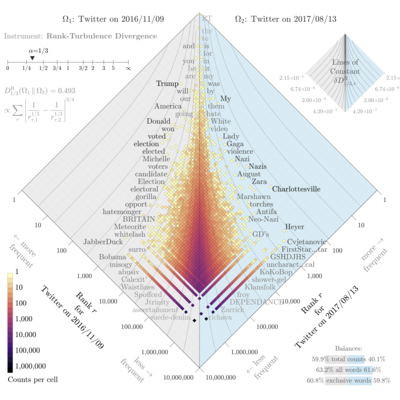Allotaxonometry and rank-turbulence divergence: A universal instrument for comparing complex systems
P. S. Dodds, J. R. Minot, M. V. Arnold, T. Alshaabi, J. L. Adams, D. R. Dewhurst, T. J. Gray, M. R. Frank, A. J. Reagan, C. M. Danforth

Times cited: 29
Logline: Complex systems often comprise many interacting parts of greatly varying number and size. Understanding how complex systems evolve or how two systems compare can be done powerfully through 'allotaxonographs': Dynamic dashboards of coupled maps and lists which show changes in component importance. Rank-turbulence divergence is a particular tunable instrument of allotaxonometry that can be applied to any pair of complex systems with meaningfully rankable components.
Abstract:
Complex systems often comprise many kinds of components which vary over many orders of magnitude in size: Populations of cities in countries, individual and corporate wealth in economies, species abundance in ecologies, word frequency in natural language, and node degree in complex networks. Comparisons of component size distributions for two complex systems—or a system with itself at two different time points—generally employ information-theoretic instruments, such as Jensen-Shannon divergence. We argue that these methods lack transparency and adjustability, and should not be applied when component probabilities are non-sensible or are problematic to estimate. Here, we introduce 'allotaxonometry' along with 'rank-turbulence divergence', a tunable instrument for comparing any two (Zipfian) ranked lists of components. We analytically develop our rank-based divergence in a series of steps, and then establish a rank-based allotaxonograph which pairs a map-like histogram for rank-rank pairs with an ordered list of components according to divergence contribution. We explore the performance of rank-turbulence divergence for a series of distinct settings including: Language use on Twitter and in books, species abundance, baby name popularity, market capitalization, performance in sports, mortality causes, and job titles. We provide a series of supplementary flipbooks which demonstrate the tunability and storytelling power of rank-based allotaxonometry.
- This is the default HTML.
- You can replace it with your own.
- Include your own code without the HTML, Head, or Body tags.
BibTeX:
@Misc{dodds2020a,
author = {Dodds, Peter Sheridan and Minot, Joshua R. and
Arnold, Michael V. and Alshaabi, Thayer and Adams,
Jane Lydia and Dewhurst, David Rushing and Gray,
Tyler J. and Frank, Morgan R. and Reagan, Andrew
J. and Danforth, Christopher M.},
title = {Allotaxonometry and rank-turbulence divergence: {A}
universal instrument for comparing complex systems},
year = {2020},
note = {Available online at
\href{https://arxiv.org/abs/2002.09770}{https://arxiv.org/abs/2002.09770}},
}